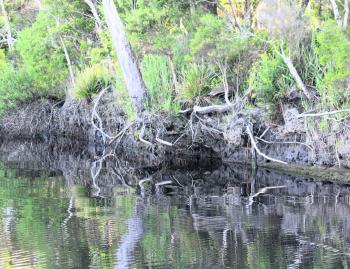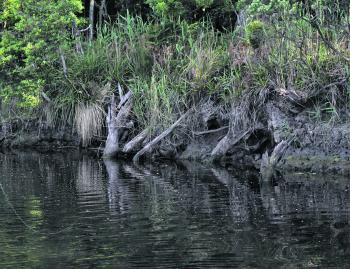Mulloway are often described as the ghosts of the estuary, but as elusive as they are, estuary perch can be quite the ghosts themselves. Scattered far and wide around the coastlines of Victoria, South Australia and New South Wales, EPs as they are more affectionately known are a highly sought species – especially for lure enthusiasts.
They can be targeted with bait, but it is the lure-flicking brigade that takes pride in working the confines of an estuary to lock horns with these fish that can towel you up in seconds.
It’s not easy to know where to begin when it comes to perch. First things first, you need the right location and Victoria has plenty of prime ‘perch water’ right around the coast. From west to east, Glenelg River, Nelson, Patterson River, Carrum, Western Port, Anderson Inlet, Inverloch, Gippsland, Lakes Entrance, Marlo, Mallacoota and many rivers in between are some of the best waterways to start.
We may not have the iconic barramundi swimming in our waterways, but we do have estuary perch, and for what they lack in size, they make up for in every other way. Take on a 40cm perch in a river full of hidden snags, and you’re in for one epic battle.
Perch share similar characteristics to barra in that they are notorious for being temperamental in the event of a change in barometric pressure, tidal influence, moon phase and other environmental factors that can switch them off in a heart beat. Getting all these to align on any given day isn’t the easiest of tasks but you can always pick the best day of the week to try your luck. Perch are nocturnal feeders and will be more active through a full moon period. During the day, they can be difficult to entice to the lure due to their nocturnal feeding schedule. On the flip side, a new moon or dark moon can be more productive during the day, as baitfish aren’t as easy to find by night.
Barometric pressure also plays a huge part and can have an adverse effect on them. A drop in barometric pressure can shut the fish down and make them almost dormant, however, if a thunderstorm approaches they can briefly go nuts in a feeding frenzy. Unfortunately, this is one of those factors that you have to persist with and if they bite, they’ll bite.
Tidal influence on the other hand dictates where the fish will hold. On a high tide, they will be held up tight higher in the snags and hard in on the banks or under the brush. During an ebb or low tide, they will hide deeper in the snags, under a rock ledge or swim off the bank and into the main body of the river among the weed beds or other deep snags. Often you can find them lurking around the mouth of a small creek or river where bait and other potential foods will be funnelled.
Perch aren’t always easy to locate as they inhabit logs, snags and weed beds. In saying that, you can work an entire side of a river, casting at every snag along the way for nothing, come back to where you started, cast to the opposite bank, and hook one. Perch are a schooling fish and like barra, they choose a specific snag or locations to hide in, where food is funnelled with the current so they don’t have to waste unnecessary energy searching for it themselves.
Locating fish is imperative, and with technology improving, a good sounder with side scan can take all of the casting work out of the equation. You’ll simply have to pepper a few snags where you have discovered fish.
There is a saying ‘don’t take a knife to a gun fight’ and the same saying applies when it comes to targeting EPs. Given the terrain they are found, going too light on them can be costly, especially to your lure box. Perch are lure-munching machines and although you do need to toss them the yummiest of all yummy lures, you do need to have the right piece of weaponry for the job.
The discussion of what rod/reel outfit to catch fish with is almost always written about in magazine articles for good reason. Rod blanks are suited for different styles of fishing. Someone using a 702NT fibreglass rod will have no hope of flicking a 1/8oz jighead with an 85mm Wriggler soft plastic more than 5ft, and of course will lose all accuracy once the lure leaves the rod tip. A graphite rod on the other hand will cast such a lightweight a great distance as well as aid in providing the perfect accuracy to land the lure right next to a snag – the perfect cast. Graphite rods allow manipulation of the lure to act like a real fish, water bug or insect that may be familiar to perch. Of course, working a lure in the perfect manner can’t be done with monofilament line due to its stretch, whereas braid allows this to occur as you can keep the line tight to the lure and work it feeling everything it does in the water.
When it’s time to get your arsenal into gear, success is always about selection. Choosing lures is an angler’s worst nightmare and fish are selective so you need have a good variety of colours, actions and models at your disposal. Perch will devour pretty much anything thrown at them but have a special liking for brighter colours. Pinks, purples, yellows, greens and of course natural colours should be a common range in any estuarine angler’s box.
A typical perch lure is no different to a bream lure, in fact, they can all be used for the same species and when you’re casting for perch, you’ll hook plenty of bream along the way.
I have a personal affection for suspending hardbody lures, both deep and shallow diving such as Zerek’s PM and RD Tango Shad, Yakamito Waka and Ayu SXY Shad and Shiver Shallow and Yo-Zuri SHGM Eba Shads. Sinking stick baits such as the Yakamito Clear Prawn Intruder works well.
These lures, and all lures in fact, should have their hook upgraded to the sharpest available. Although the majority of lures available on the market are fitted with VMC trebles, you only get one shot at hooking a perch so you want the best hooks available to fit that bill. In my case, all lures are retro-fitted with Mustad 35657BN Bream Trebles due to their sharpness and strength, which you need to pull the fish from the snag.
Finding, enticing and landing perch is no easy task and as much fun as they are to catch, they do deserve a lot of respect. These powerful lure crunchers are very slow growers. A fish around 26-36cm in length can be 8-10 years of age. Take a fish between 28-48cm and it could be as old as 15-20 years. To date, the eldest recorded perch was 40cm and 41 years old.
If you are going to embark on a perch search, respect the fish, practice CPR (catch, photograph and release) and let them grow, spawn and multiply for future generations to enjoy.
Reads: 5224
Perch can be an elusive estuarine species. If you’re ever going to find one, work the snags to find success.

Perch can be found deep in snags, and coaxing them out can be a challenge. Always ensure you work the snag with suspending, floating and sinking lures to entice them to attack.

Submerged snags are where you’ll find perch holding. Working these requires twitching a suspending crankbait along each side of the timber.

Although you might be targeting perch, catching bream is inevitable.

Perch love eating lures, however you still do need to work them with a finesse approach. Pausing the lure for a period of time will instigate a strike.

Don’t be in a hurry to work an area; it takes patience to catch perch and many casts.

The rewards are great; they don’t call them the southern barra for nothing!

Small lures can be extremely effective, so ensure you have a wide variety at your disposal.

Lure selection is critical but don’t go to a gun battle without bullets, always make sure you have every base covered when targeting perch.




